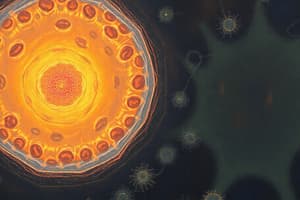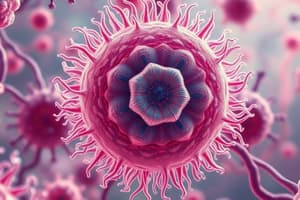Podcast
Questions and Answers
Explain how the structural differences between prokaryotic and eukaryotic cells impact their relative sizes and complexities.
Explain how the structural differences between prokaryotic and eukaryotic cells impact their relative sizes and complexities.
The lack of internal membrane-bound organelles in prokaryotes leads to a smaller size and less complexity compared to eukaryotes, which have a nucleus and other organelles, allowing for larger size and compartmentalization of functions.
Considering that both prokaryotes and eukaryotes contain ribosomes, what might be a plausible explanation for why their ribosome structures are different?
Considering that both prokaryotes and eukaryotes contain ribosomes, what might be a plausible explanation for why their ribosome structures are different?
Differences in ribosome structure likely reflect evolutionary divergence and adaptation to different cellular environments, with variations in ribosomal proteins and RNA sequences influencing translational efficiency and regulation.
If a cell were found to have a cell wall made of polysaccharides, but lacked a membrane-bound nucleus, how would you classify this cell and why?
If a cell were found to have a cell wall made of polysaccharides, but lacked a membrane-bound nucleus, how would you classify this cell and why?
I would classify the cell as a prokaryote because prokaryotes have a cell wall composed of polysaccharides and lack a membrane-bound nucleus, whereas eukaryotes do not have a polysaccharide cell wall.
Contrast the organization of genetic material in prokaryotic versus eukaryotic cells, and explain the implications of these differences.
Contrast the organization of genetic material in prokaryotic versus eukaryotic cells, and explain the implications of these differences.
Considering that both prokaryotic and eukaryotic cells possess a plasma membrane, what fundamental function does this shared structure provide to all cells?
Considering that both prokaryotic and eukaryotic cells possess a plasma membrane, what fundamental function does this shared structure provide to all cells?
Describe the evolutionary significance of prokaryotic cells being the first life forms on Earth.
Describe the evolutionary significance of prokaryotic cells being the first life forms on Earth.
Explain why the presence of membrane-bound organelles in eukaryotic cells allows for greater complexity and efficiency in cellular processes compared to prokaryotic cells.
Explain why the presence of membrane-bound organelles in eukaryotic cells allows for greater complexity and efficiency in cellular processes compared to prokaryotic cells.
How does the absence of a nucleus in prokaryotic cells affect the processes of transcription and translation, compared to eukaryotic cells?
How does the absence of a nucleus in prokaryotic cells affect the processes of transcription and translation, compared to eukaryotic cells?
If you were to observe a cell under a microscope and notice the presence of flagella, what could you infer about the cell's capabilities and its possible classification as prokaryotic or eukaryotic?
If you were to observe a cell under a microscope and notice the presence of flagella, what could you infer about the cell's capabilities and its possible classification as prokaryotic or eukaryotic?
Describe the implications of eukaryotes being either single-celled or multicellular, versus prokaryotes being exclusively single-celled.
Describe the implications of eukaryotes being either single-celled or multicellular, versus prokaryotes being exclusively single-celled.
Explain the role of the cell wall in prokaryotic cells and discuss how its composition differs from that of eukaryotic cells that possess a cell wall.
Explain the role of the cell wall in prokaryotic cells and discuss how its composition differs from that of eukaryotic cells that possess a cell wall.
How might the comparatively simple structure of prokaryotic cells enable them to reproduce more quickly and adapt more effectively to changing environments compared to eukaryotic cells?
How might the comparatively simple structure of prokaryotic cells enable them to reproduce more quickly and adapt more effectively to changing environments compared to eukaryotic cells?
Compare and contrast the functions of DNA in prokaryotic and eukaryotic cells, considering their respective cellular structures.
Compare and contrast the functions of DNA in prokaryotic and eukaryotic cells, considering their respective cellular structures.
If you were studying a new organism and discovered its cells lacked membrane-bound organelles, what experiments could you perform to determine if it was a bacteria or archaea?
If you were studying a new organism and discovered its cells lacked membrane-bound organelles, what experiments could you perform to determine if it was a bacteria or archaea?
Considering that both prokaryotes and eukaryotes have cytoplasm, what essential cellular processes occur in this region of the cell, and how might they differ between the two cell types?
Considering that both prokaryotes and eukaryotes have cytoplasm, what essential cellular processes occur in this region of the cell, and how might they differ between the two cell types?
Explain why antibiotics are typically designed to target prokaryotic cellular processes, rather than eukaryotic ones, in the treatment of bacterial infections.
Explain why antibiotics are typically designed to target prokaryotic cellular processes, rather than eukaryotic ones, in the treatment of bacterial infections.
How does the presence of a nucleus in eukaryotic cells impact the post-transcriptional modification of mRNA, and what advantages does this provide to the organism?
How does the presence of a nucleus in eukaryotic cells impact the post-transcriptional modification of mRNA, and what advantages does this provide to the organism?
Describe how the presence or absence of membrane-bound organelles influences the energy production strategies of prokaryotic and eukaryotic cells.
Describe how the presence or absence of membrane-bound organelles influences the energy production strategies of prokaryotic and eukaryotic cells.
Considering the differences in DNA organization between prokaryotic and eukaryotic cells, predict how these differences impact the rate of mutation and genetic variation in these two cell types.
Considering the differences in DNA organization between prokaryotic and eukaryotic cells, predict how these differences impact the rate of mutation and genetic variation in these two cell types.
How do the structural differences between prokaryotic and eukaryotic flagella reflect differences in their mechanisms of movement and energy utilization?
How do the structural differences between prokaryotic and eukaryotic flagella reflect differences in their mechanisms of movement and energy utilization?
Flashcards
Prokaryotic Cells
Prokaryotic Cells
The simplest and most ancient cell types, lacking a nucleus and other membrane-bound organelles.
Nucleoid Region
Nucleoid Region
Region in prokaryotic cells where DNA is located, but is not enclosed by a membrane.
Prokaryotic Cell Wall
Prokaryotic Cell Wall
A structure surrounding the plasma membrane in prokaryotes, composed of polysaccharides.
Eukaryotic Cells
Eukaryotic Cells
Signup and view all the flashcards
Prokaryote/Eukaryote Similarities
Prokaryote/Eukaryote Similarities
Signup and view all the flashcards
Key Cell Differences
Key Cell Differences
Signup and view all the flashcards
Prokaryote Organization
Prokaryote Organization
Signup and view all the flashcards
Eukaryote Organization
Eukaryote Organization
Signup and view all the flashcards
DNA Arrangement
DNA Arrangement
Signup and view all the flashcards
Study Notes
- There are two major types of cells on Earth: prokaryotic and eukaryotic
Prokaryotic Cells
- Prokaryotic cells are the simplest and most ancient cell types.
- Prokaryotic cells existed as the only form of life on Earth for billions of years before eukaryotic cells evolved.
- Prokaryotic cells are smaller than eukaryotic cells.
- They possess a simpler structure.
- Their simple structure allows them to reproduce quickly and effectively.
- Prokaryotic cells lack a nucleus.
- The term "prokaryote" means "before nucleus".
- The inside of a prokaryotic cell is an open unit without compartments or membrane-bound organelles.
- Ribosomes are scattered throughout the cytoplasm.
- DNA is located in the nucleoid region, which is not enclosed by a membrane.
- Prokaryotes have a cell wall surrounding the plasma membrane.
- Cell wall composition varies between archaea and bacteria but consists of polysaccharides.
- Prokaryotes often have flagella for movement.
Eukaryotic Cells
- Eukaryotic cells contain a membrane-bound nucleus and other membrane-bound organelles.
- The word "eukaryote" means "true nucleus".
- Eukaryotic cells are larger and more complex than prokaryotic cells.
Similarities between Prokaryotes and Eukaryotes
- Both have DNA as their genetic material.
- Both have ribosomes.
- Both have cytoplasm.
- Both have a plasma membrane.
Differences between Prokaryotes and Eukaryotes
- Prokaryotic cells are the oldest, small, and relatively simple.
- Eukaryotic cells evolved later from prokaryotic cells, and are larger and more complex.
- Prokaryotes lack a nucleus and membrane-bound organelles.
- Eukaryotic cells have a nucleus and other organelles.
- Prokaryotes are single-celled organisms.
- Eukaryotes can be single-celled or multicellular.
- Prokaryote DNA is usually a single, circular chromosome.
- Eukaryote DNA is organized as linear chromosomes.
Studying That Suits You
Use AI to generate personalized quizzes and flashcards to suit your learning preferences.




